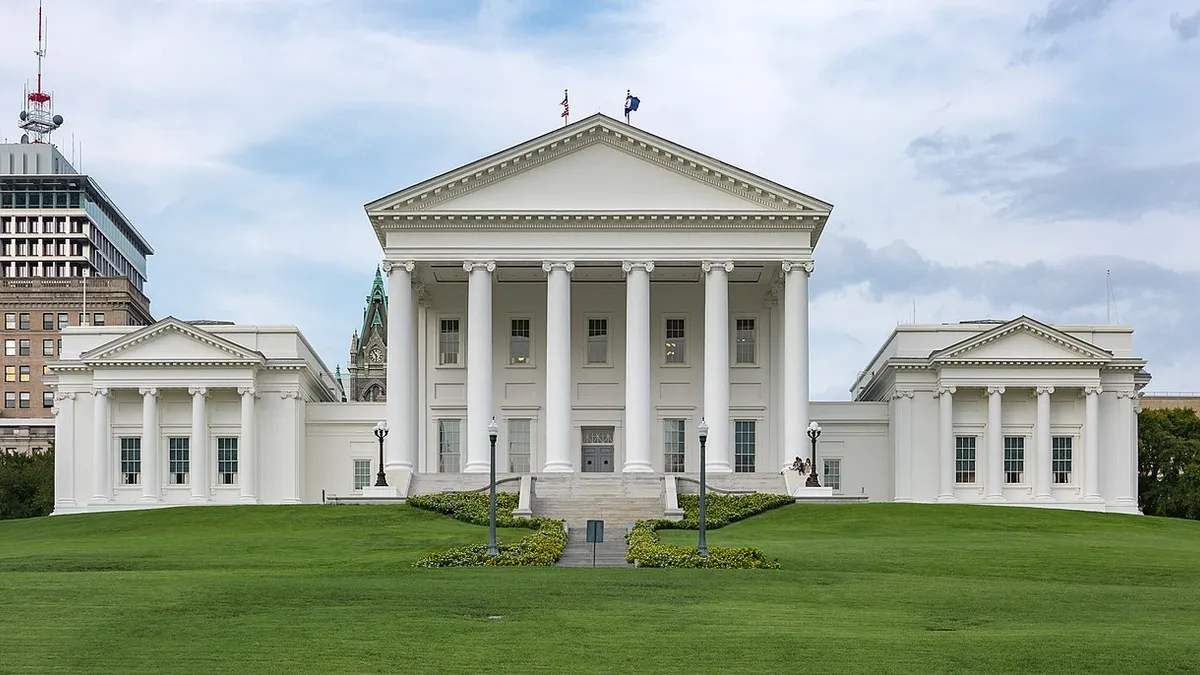UPDATE: March 6, 2020: The final version of the Clean Economy Act is headed to the governor's desk, after the Virginia Senate pushed for a conference committee to advance the bill as the state's legislative session comes to an end. The House passed it Thursday with a 51-45 vote, while the Senate approved it Friday morning, 22-17.
Dive Brief:
- The Virginia Clean Economy Act, narrowly passed by both chambers of the state legislature, sets one of the largest energy storage targets in the country at 2.4 GW by 2035 and pushes state regulators to devise a carbon dioxide cap and trade program that complies with the Regional Greenhouse Gas Initiative (RGGI).
- The act, which requires Virginia’s electric utilities and competitive suppliers to generate electricity from 100% renewable energy by 2050, passed on the same day that Dominion Energy, by far the state’s largest utility, announced its own commitment to achieve net-zero emissions by 2050.
- Other provisions of the legislation give regulators additional powers to block the construction of new power plants that emit carbon dioxide, a potentially significant change for a state that has attracted criticism for an alleged glut of natural gas-fired power plant construction in recent years.
Dive Insight:
Virginia’s Clean Economy Act codifies into law the goal of clean energy by 2050 that was previously outlined in an executive order from Gov. Ralph Northam, D, in September 2019. The House version of the bill passed with a vote of 52 in favor and 47 opposed, and the Senate version passed with 21 in favor and 19 opposed.
The close votes reflected a regional split, as reported by Virginia Mercury, with Republicans who represent rural parts of Virginia claiming the bill would increase costs for ratepayers. Costs related to the RGGI program have been particularly controversial. RGGI is a market-based program in which participating states, primarily in the Northeast, adhere to a carbon dioxide cap and trade carbon dioxide allowances.
In its 2018 integrated resource plan, Dominion had concluded that an earlier proposal to create a Virginia cap and trade program linked to RGGI would increase costs for Virginia customers by $530 million from 2020 to 2030 while not significantly lowering emissions. “The modeling indicates that Virginia joining or linking to RGGI will lower allowance prices, thereby lowering the cost of carbon compliance in other RGGI states subsidized, in part, by Virginia electricity customers,” the IRP stated.
The Clean Economy Act “directs the [State Air Pollution Control Board] to adopt regulations establishing a carbon dioxide cap and trade program to limit and reduce the total carbon dioxide emissions released by electric generation facilities, which regulations shall comply with the Regional Greenhouse Gas Initiative model rule,” according to the texts of both versions.
Besides the RGGI provision, the bill takes additional steps to require carbon dioxide emissions reductions. It prevents the Virginia State Corporation Commission from approving “any investor-owned utility to own, operate, or construct any electric generating unit that emits carbon as a byproduct of combusting fuel to generate electricity” until the state legislature has had a chance to review a report from the Air Pollution Control Board. The bill also requires utilities and the commission to consider the social cost of carbon when reviewing the need for a new generation facility.
The legislation sets targets for both energy storage and offshore wind. The 2.4 GW deployment target for energy storage includes interim targets through 2035, requiring the State Corporation Commission to approve new energy storage projects. On offshore wind, the bill states that the commission should approve new offshore wind projects up to 5.2 GW in capacity through the end of 2034. Dominion has already proposed a 2.6 GW wind project off the Virginia coast for 2024.
In a letter published by the Washington Post, Food & Water Watch Southern Region Director Jorge Aguilar called the Virginia Clean Economy Act a “weak foundation for renewable energy transformation,” arguing that “the legislation mostly mirrors what utilities have already committed to.” Prior to the Feb. 11 announcement of net-zero emissions by 2050, Dominion had targeted an 80% reduction in emissions by 2050.
NGO Environment Virginia, however, praised the bill. “The Virginia Clean Economy Act incorporates best-practice policies with data-driven roadmaps that will put Virginia on an aggressive but practical path to curb emissions while protecting rate-payers,” the group said.














